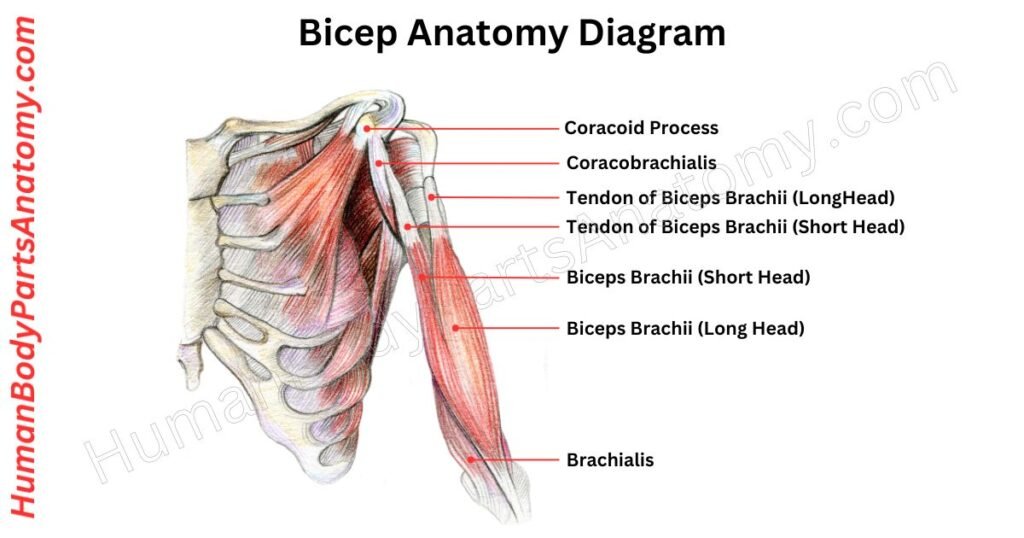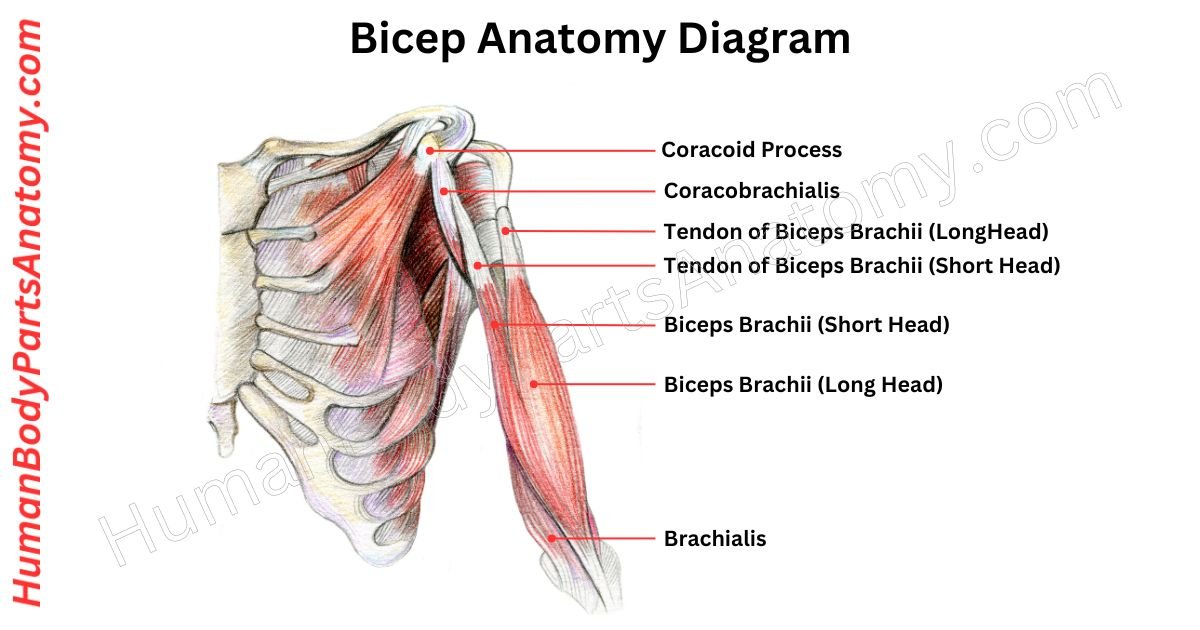📅 Published on January 27, 2024 | 🕒 Last updated on November 2, 2025
Overview of Biceps Anatomy
The biceps is an important part of the upper arm. We call it a single muscle consisting of a short and a long head. The short head starts at the coracoid, while the long head originates from the supraglenoid tubercle. Both parts share the same nerve supply with the coracobrachialis and brachialis muscles. One good thing about the biceps is its attachment to two points in the shoulder – the coracoid process and supraglenoid tubercle. What makes the biceps unique is its ability to span two joints, the shoulder and elbow, setting it apart from other muscles in the upper arm’s front compartment. In this article, we will see a detailed bicep anatomy with its different parts and their functions.
Anatomy of Bicep Diagram

Parts of Bicep
- Short head
- Long head
- Brachialis
- Muscle belly
- Innervation
Bicep Anatomy: Parts & Functions
Short Head
The short head, on top of the coracobrachialis muscle, starts at the highest spot on the shoulder blade’s coracoid process. It is where it links up with the beginning of the coracobrachialis tendon.
Long Head
The long head of the biceps starts at the supraglenoid tubercle above the shoulder socket on the shoulder blade. It stays outside the joint but within its surroundings.
The long biceps tendon takes a sudden bend at the top of the upper arm bone and moves along the groove between the two bumps on the upper arm bone. This bend is held in place by ligaments in the area around the joint (called the biceps pulley).
- Long head of the biceps tendon pain: differential diagnosis and treatment.
- Diagnosis and treatment of distal biceps and anterior elbow pain in throwing athletes.
Brachialis
The brachialis muscle is a powerhouse deep within the upper arm. This muscle plays a pivotal role in elbow flexion. It gives stability and strength to the joint.
Muscle Belly
When you flex your belly hard, the middle part—the muscle belly—pops up. It comprises two parts of the biceps, like ropes woven together. Inside, there are lots of tiny muscle fibers.
These fibers get super strong when your brain tells them to move. Surrounding these fibers is the epimysium protective layer, which helps your muscles look big and strong.
Innervation
The biceps muscle gets its power from a nerve called the musculocutaneous nerve. It comes from nerves in your neck and upper back called the brachial plexus. This nerve, which starts from spinal nerves C5-C6, helps the biceps move and work properly.
FAQ’s
The biceps muscle attaches to the shoulder blade (scapula) at two points—the coracoid process and the supraglenoid tubercle—and inserts into the radius bone in the forearm. This connection allows the biceps to assist in both elbow and shoulder movement.
The biceps primarily act on the elbow joint, helping with flexion (bending the arm), and on the shoulder joint, assisting in lifting and stabilizing the arm.
The biceps help bend the elbow (flexion) and rotate the forearm (supination, such as turning your palm upward). They also play a role in stabilizing the shoulder during lifting and pulling movements.
Post-exercise soreness is often due to microscopic muscle tears, commonly known as delayed onset muscle soreness (DOMS). This is normal and improves with rest, stretching, hydration, and proper warm-ups. Persistent or sharp pain, however, may indicate injury.
Common issues include bicep tendonitis (inflammation of the tendon), biceps strain (muscle tear), and tendon rupture. These conditions can cause pain, swelling, or weakness in the arm.
Effective exercises include bicep curls, hammer curls, and chin-ups. To avoid injury, start with moderate weights, maintain proper form, and increase resistance gradually.
Yes. Bicep pain can sometimes stem from shoulder or elbow joint issues, such as rotator cuff injuries, arthritis, or tendon inflammation. Consulting a doctor is advised if pain persists.
Seek medical help if you notice sudden, sharp pain, swelling, bruising, weakness in the arm, or a popping sound during activity. These could be signs of a tendon tear or serious injury.
Read More-
Lower Limb
- Complete Guide on Leg Anatomy with Parts, Functions & Diagram
- Complete Guide to Thigh Muscle Anatomy: Learn Parts, Names & Diagram
- Knee Anatomy: Complete Guide to Parts, Names, Functions & Diagram
- Femur Anatomy: Complete Guide with Parts, Names, Functions & Diagram
Upper Limb
- Comprehensive Guide to Arm Anatomy: Parts, Names & Diagram
- Comprehensive Guide to Hand Anatomy: Parts, Functions & Diagram
- Shoulder Anatomy: Ultimate Guide to Parts, Names, Functions & Diagram
- Complete Guide to Finger Anatomy with Parts, Names, Functions & Diagram
- Wrist Anatomy: Ultimate Guide to Parts, Names, Functions & Diagram
- Complete Guide to Nail Anatomy with all Parts, Names & Diagrams
External Sources-
- Wikipedia
- KenHub
- Optometrists
- Cleveland Clinic
- American Academy of Ophthalmology
Official websites of the United States government
- Does bicep pathology affect rotator cuff repair outcomes?
- Left neck and right biceps muscle vibrations have similar effects on perceived body orientation.
Medical Disclaimer
All content on HumanBodyPartsAnatomy.com is educational and based on verified, peer-reviewed medical sources. Articles are authored or reviewed by qualified medical or biomedical professionals to ensure accuracy.
This website does not provide medical advice, diagnosis, or treatment. Always consult a licensed healthcare professional for personal medical guidance.
No commercial or promotional interests influence the medical content published on this site.

